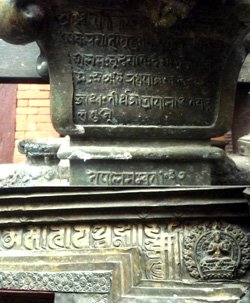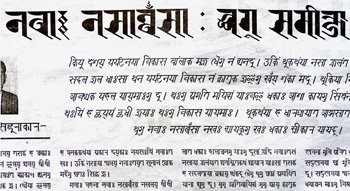Download Newari Font
| Ranjana Regular Newari Font Popular |
| Prachalit 1 Newari Font New |
| Prachalit 2 Newari Font New |
| Brahmi Newari Font New |
How to Install Newari Font?
- Download the selected Newari Font.
- Extract Zipped Newari Font using RAR Software
- Go to Control Panel, and open the "Fonts" Folder.
- Copy the font from the extracted folder and paste it into the "Fonts" Folder.
Alternative Way: Alternative Way:
- Double click the font file and font book will open a preview of the font. Click "install font" at the bottom of the preview.
The Newar's Nepal Bhasha and Nepal Lipi
Pat Hall, Language Technology Kendra, Patan, Nepal [email protected]1. Style of Writing Nepal Bhasha (Nepal Language)
Forget the Gurkhas — the Newar people have been rulers of the Kathmandu Valley for many centuries and continue to be culturally dominant [1]. They call the Kathmandu Valley "Nepal," and their language "Nepal Bhasha" — the language of the Kathmandu Valley or Nepal [2]. Their writing system was called "Nepal Lipi" or "Nepaalalipi" [3]. Throughout temples around the Kathmandu Valley, you can observe their writing carved into stone or wood, or embossed in brass and other metals.
There are two distinct styles of writing: an ornate style with many long downward strokes, called "Ranjana," and a more rounded style, called "Prachalit" [4]. Both of these Newar fonts can be downloaded by clicking on the above links.
Although these two are not the oldest examples of their writing, very old specimens can be seen in the nearby Patan Museum. Other styles of writing have also appeared. Rabison Shakya, in his comprehensive book on how to write Nepal Bhasa, identifies a third style which he refers to as "Bhujimmola" [5], while Hemraj Shakyavansha (1985) identified nine distinct styles [6]. Different styles appear to have been used for different purposes — Ranjana for sacred and religious texts, Prachalit for everyday secular writings, and Bhujimmola for administrative purposes.
Around 1998, a proposal was submitted to Unicode by a committee in Nepal for a distinct encoding for the Nepali script, to include three common consonant compounds (conjuncts) — {tra}, {ksha}, and {gya} — which collate separately and are taught as part of the basic alphabet in Nepal [7]. This proposal was rejected on the basis that the three conjuncts did not constitute a distinct writing system and should continue to be treated as conjuncts, with the collation differences handled through collation algorithms [8]. This reasoning seemed fair enough, and subsequently software was developed for the Nepali language using the Unicode Devanagari code block.
2. Early Attempts to Encode Nepal Lipi (Nepaalalipi)
In 2001, the Unicode expert Michael Everson posted a proposed code block which he named "Newari," illustrated with graphic characters from Ranjana [9]. Around the same time, he posted a draft code block named "Nepali," illustrated with graphic characters from Prachalit (this posting is no longer available) [10]. What was noteworthy about these drafts was their inclusion of the same three conjuncts — {tra}, {ksha}, and {gya} — as in the earlier proposal for Nepali, presumably influenced by it.
Although the Newar community already had 8-bit hack fonts for their writing (Shakya’s 2002 book could be viewed as a description of his 8-bit hack fonts) [11], a number of Newar activists began to take an interest in Unicode standards for Newar writing, expressing ideas as proposed code blocks. A meeting of the Nepal Lipi Guthi in July 2008 explored the notion that each style of writing should be separately encoded and that the actual shapes of the characters themselves should be standardised [12].
I became involved around this point and studied Shakya’s book to learn more about the writing of Nepal Bhasa and how it differed from Devanagari, which I knew was often used to write Nepal Bhasa. Shakya provides small tables of the basic characters of Ranjana, Prachalit, and Bhujimmola, but to my surprise these were not equivalent — the Prachalit tables had significantly more characters, as can be seen in Figure 5 for the consonants of the three writing styles [13].
Ranjana Newari Scripts Vowel and Consonant
-
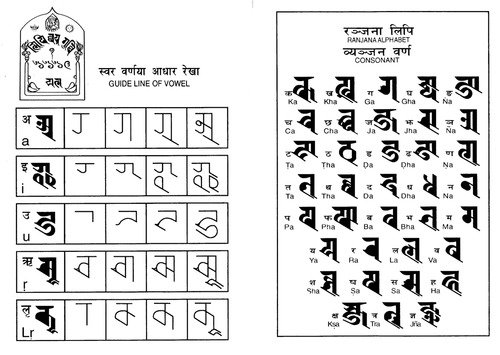
Ranjana Newari Scripts Alphabet Vowel & Consonant
-
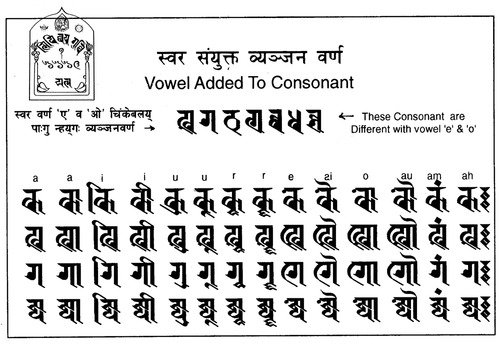
Ranjana Newari Scripts Vowel Added to Consonant
-
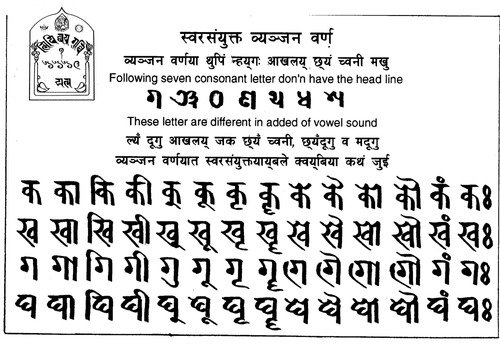
Ranjana Newari Letters Different in Added Vowel Sound
-
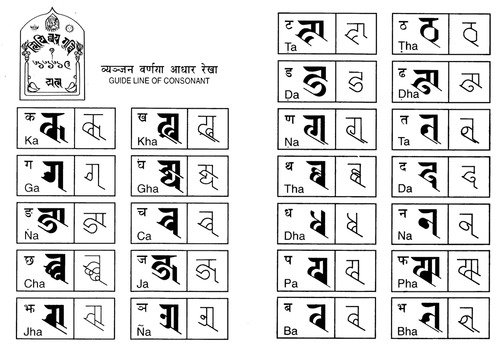
Ranjana Newari Language Guidelines for Consonants
-
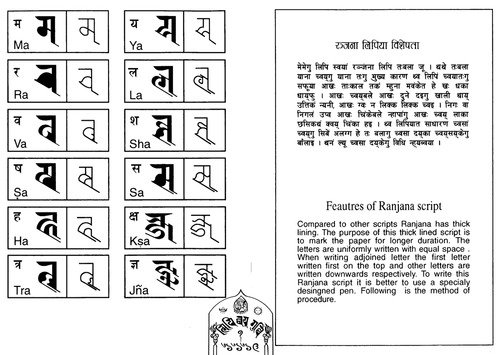
Features of Ranjana Script
References:
- [1] Gellner, David N. "The Anthropology of Buddhism and Hinduism: Weberian Themes". Oxford University Press, 2001. Retrieved from Oxford Academic
- [2] Malla, Kamal P. "The Newari Language: A Working Outline". Karna Shakya, 1985. Retrieved from Himalayan Art Resources
- [3] Unicode Consortium. "The Unicode Standard, Version 14.0". Unicode, Inc., 2021. Retrieved from https://www.unicode.org/versions/Unicode14.0.0/
- [4] Shrestha, Tej Ratna. "Nepal Bhasa Scripts and Literature". Royal Nepal Academy, 1992. Retrieved from Nepal Academy
- [5] Shakya, Rabison. "How to Write Nepal Bhasa". Self-published, 2002. Retrieved from https://github.com/newarscript/fonts
- [6] Shakyavansha, Hemraj. "Nepal Lipi: Nine Traditional Scripts". Cultural Heritage Research, 1985.
- [7] Unicode Technical Committee. "Unicode Proposal for Nepali Script Enhancement". Unicode Consortium, 1998. Retrieved from https://www.unicode.org/L2/L1998/
- [8] Unicode Technical Committee. "UTC Meeting Minutes: Nepali Script Proposal Review". Unicode Consortium, 1998. Retrieved from https://www.unicode.org/consortium/utc-minutes.html
- [9] Everson, Michael. "Proposal to add the Newari script to the UCS". ISO/IEC JTC1/SC2/WG2, 2001. Retrieved from https://www.unicode.org/L2/L2001/
- [10] Everson, Michael. "Draft proposal for Nepali script encoding". Unicode Consortium Archives, 2001.
- [11] Shakya, Rabison. "8-bit Font Encoding for Nepal Bhasa". Self-published technical documentation, 2002.
- [12] Nepal Lipi Guthi. "Meeting Minutes: Unicode Standardisation Discussion". Internal Documentation, July 2008.
- [13] Hall, Pat. "Character Analysis of Nepal Bhasa Writing Systems". Language Technology Kendra, 2008.
Last Updated On:
